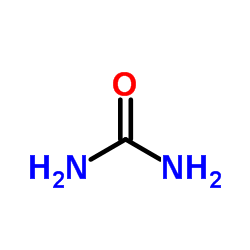CHEMICAL IDENTIFICATION
-
RTECS NUMBER :
-
YU1700000
-
CHEMICAL NAME :
-
Urease
-
CAS REGISTRY NUMBER :
-
9002-13-5
-
LAST UPDATED :
-
199701
HEALTH HAZARD DATA
ACUTE TOXICITY DATA
-
TYPE OF TEST :
-
LD50 - Lethal dose, 50 percent kill
-
ROUTE OF EXPOSURE :
-
Intraperitoneal
-
SPECIES OBSERVED :
-
Rodent - rat
-
DOSE/DURATION :
-
48 mg/kg
-
TOXIC EFFECTS :
-
Sense Organs and Special Senses (Eye) - lacrimation Behavioral - sleep Kidney, Ureter, Bladder - urine volume increased
-
REFERENCE :
-
AJPHAP American Journal of Physiology. (American Physiological Soc., 9650 Rockville Pike, Bethesda, MD 20814) V.1- 1898- Volume(issue)/page/year: 206,731,1964
-
TYPE OF TEST :
-
LD50 - Lethal dose, 50 percent kill
-
ROUTE OF EXPOSURE :
-
Intravenous
-
SPECIES OBSERVED :
-
Rodent - rat
-
DOSE/DURATION :
-
20 mg/kg
-
TOXIC EFFECTS :
-
Behavioral - somnolence (general depressed activity) Behavioral - convulsions or effect on seizure threshold
-
REFERENCE :
-
AJPHAP American Journal of Physiology. (American Physiological Soc., 9650 Rockville Pike, Bethesda, MD 20814) V.1- 1898- Volume(issue)/page/year: 206,731,1964
-
TYPE OF TEST :
-
LD50 - Lethal dose, 50 percent kill
-
ROUTE OF EXPOSURE :
-
Intraperitoneal
-
SPECIES OBSERVED :
-
Rodent - mouse
-
DOSE/DURATION :
-
50 mg/kg
-
TOXIC EFFECTS :
-
Sense Organs and Special Senses (Eye) - lacrimation Behavioral - sleep Kidney, Ureter, Bladder - urine volume increased
-
REFERENCE :
-
AJPHAP American Journal of Physiology. (American Physiological Soc., 9650 Rockville Pike, Bethesda, MD 20814) V.1- 1898- Volume(issue)/page/year: 206,731,1964
-
TYPE OF TEST :
-
LD50 - Lethal dose, 50 percent kill
-
ROUTE OF EXPOSURE :
-
Subcutaneous
-
SPECIES OBSERVED :
-
Rodent - mouse
-
DOSE/DURATION :
-
58 mg/kg
-
TOXIC EFFECTS :
-
Details of toxic effects not reported other than lethal dose value
-
REFERENCE :
-
AJPHAP American Journal of Physiology. (American Physiological Soc., 9650 Rockville Pike, Bethesda, MD 20814) V.1- 1898- Volume(issue)/page/year: 206,731,1964
-
TYPE OF TEST :
-
LD50 - Lethal dose, 50 percent kill
-
ROUTE OF EXPOSURE :
-
Intraperitoneal
-
SPECIES OBSERVED :
-
Rodent - rabbit
-
DOSE/DURATION :
-
25 mg/kg
-
TOXIC EFFECTS :
-
Sense Organs and Special Senses (Eye) - lacrimation Behavioral - sleep Kidney, Ureter, Bladder - urine volume increased
-
REFERENCE :
-
AJPHAP American Journal of Physiology. (American Physiological Soc., 9650 Rockville Pike, Bethesda, MD 20814) V.1- 1898- Volume(issue)/page/year: 206,731,1964
-
TYPE OF TEST :
-
LD50 - Lethal dose, 50 percent kill
-
ROUTE OF EXPOSURE :
-
Intravenous
-
SPECIES OBSERVED :
-
Rodent - rabbit
-
DOSE/DURATION :
-
6 mg/kg
-
TOXIC EFFECTS :
-
Behavioral - somnolence (general depressed activity) Behavioral - convulsions or effect on seizure threshold Lungs, Thorax, or Respiration - dyspnea
-
REFERENCE :
-
AJPHAP American Journal of Physiology. (American Physiological Soc., 9650 Rockville Pike, Bethesda, MD 20814) V.1- 1898- Volume(issue)/page/year: 206,731,1964
-
TYPE OF TEST :
-
LD50 - Lethal dose, 50 percent kill
-
ROUTE OF EXPOSURE :
-
Intraperitoneal
-
SPECIES OBSERVED :
-
Rodent - guinea pig
-
DOSE/DURATION :
-
35 mg/kg
-
TOXIC EFFECTS :
-
Sense Organs and Special Senses (Eye) - lacrimation Behavioral - sleep Kidney, Ureter, Bladder - urine volume increased
-
REFERENCE :
-
AJPHAP American Journal of Physiology. (American Physiological Soc., 9650 Rockville Pike, Bethesda, MD 20814) V.1- 1898- Volume(issue)/page/year: 206,731,1964 *** NIOSH STANDARDS DEVELOPMENT AND SURVEILLANCE DATA *** NIOSH OCCUPATIONAL EXPOSURE SURVEY DATA : NOES - National Occupational Exposure Survey (1983) NOES Hazard Code - X3123 No. of Facilities: 1133 (estimated) No. of Industries: 3 No. of Occupations: 9 No. of Employees: 14585 (estimated) No. of Female Employees: 9975 (estimated)
|



